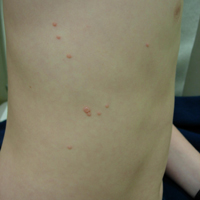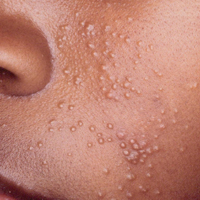Molluscum Home >
Clinical Information: Molluscum Contagiosum
Etiology
Molluscum contagiosum is a benign superficial skin disease caused by a poxvirus. It is characterized by small pearly papules with a central depression whose core may be expressed, producing a white cheesy material. The lesions average 2 to 5 mm in size and are usually painless, but may become inflamed, red, and swollen. Molluscum contagiosum is a self-limited infection; the papules usually disappear spontaneously within 6 to 12 months but may take as long as 4 years to resolve.
Clinical Features

Typical molluscum lesions on the torso
of a child. Typical lesions are
approximately 3-5 mm in diameter.
Image courtesy Dave Bray, MD, Walter
Reed Army Medical Center
View large image >
The infection is found worldwide but is more common in developing countries and has traditionally been regarded as a pediatric disease. Successful vaccination against smallpox in infancy is not protective. Little has been verified with regard to the incubation period; however, it is estimated to be between 2 weeks and 6 months. Most cases occur in children over 1 year of age, with only one known case reported in an infant (at 7 days post-partum).(32) Atopic dermatitis may be a risk factor for contracting molluscum contagiosum due to the barrier breaks and immune cell dysfunction in atopic skin.(1) In addition, these patients may be more likely to autoinoculate (excoriation of primary lesions and spread to areas of normal skin) new areas of skin because of the underlying pruritus from their atopy.(2)

Less typical-appearing numerous lesions
on
the face of a patient.
Image courtesy Scott Norton, MD, MPH,
Dept. of Dermatology,
Walter
Reed
Army
Medical Center
View large image >
Patients with HIV/AIDS and
other immunocompromising conditions (e.g., solid organ transplant recipients)(3,4)
can develop “giant” lesions (≥15 mm in diameter), larger
numbers of lesions, and lesions that are more resistant to standard
therapy. The following diseases should be considered in the differential
diagnosis of molluscum contagiosum: cryptococcosis, basal cell carcinoma,
keratoacanthoma, histoplasmosis, coccidioidomycosis, and verruca vulgaris.(2,3)
For genital lesions, condyloma acuminata and vaginal syringomas should
be considered.(4)
Diagnosis is generally made based on the appearance of lesions. Skin biopsy may be necessary in immunocompromised patients to exclude other conditions such as malignancy or endemic fungal infections. Skin biopsy will reveal “molluscum bodies” – eosinophilic inclusions in the epidermis. This finding may also be observed on Giemsa-stained core material expressed onto a glass slide.
Molluscum contagiosum lesions have recently come to be classified in one of three ways: the commonly seen skin lesions found largely on the faces, trunks, and limbs of children; the sexually transmitted lesions found on the abdomen, inner thighs, and genitals of sexually active adults; and the diffuse and recalcitrant eruptions of patients with AIDS or other immunosuppressive disorders.(6,7,10,11,15–23)
Complications
Although lesions due to molluscum are usually benign and resolve without scarring, scarring may occur from excoriation during the natural healing process in up to 7% of patients (5) or after excessive curettage. For this reason, curettage is often not recommended in otherwise healthy individuals. Secondary infections may be a problem in immunocompromised patients, such as those with HIV/AIDS or those taking immunosuppressing drug therapies. In these cases, treatment to prevent further spread of the infection is recommended.
Transmission
Spread has been documented through the sharing of towels and bathing
sponges, (6,7) wrestling, (6–8) and from a surgeon to several of
his patients.(7–9)
This implies that direct human-to-human contact and contact with infected
fomites are the most likely routes of transmission. Conflicting reports
make it unclear as to whether the disease may be spread by simple contact
with seemingly intact lesions or if the breaking of a lesion and the
subsequent transferring of core material is necessary for transmission.(6,10,11)
Secondary spread of lesions may occur by autoinoculation (excoriation
of primary lesions and spread to areas of normal skin) (9,12,31) as well
as by shaving (13) and electrolysis.(14) No known animal reservoir exists.
Swimming in public swimming pools has been implicated in molluscum transmission;
however, studies have not provided sufficient epidemiologic evidence
to confirm this association. These studies are speculative and the information
given is anecdotal at best. (6,8,12,17,24) Further evidence has linked
swimming pool equipment such as the gymnasium bar and kick boards to
the transference of molluscum contagiosum rather than the actual water
itself. (7,9,24) Furthermore, the wet, warm climate in a swimming pool
environment is believed to facilitate the spread of the virus by fomites.
(12,17) Steam baths, saunas, and communal spray baths have also been
suspected as culprits in transmission. (6,8,17)
Treatment Options
Because molluscum contagiosum is self-limited in healthy individuals, treatment may be unnecessary. Nonetheless, issues such as lesion visibility, underlying atopic disease, and the desire to prevent transmission may prompt therapy. Rapid treatment options include cryotherapy (freezing the lesion with liquid nitrogen), curettage (the piercing of the core and scraping of caseous or cheesy material), and laser therapy. These options require a trained health care provider, may require local anesthesia, and can result in post-procedural pain, irritation, and scarring. (8,10,25,26)
Gradual removal of lesions may be achieved by oral or topical therapy. These techniques are often desirable for pediatric patients because they are generally less painful and may be performed by parents at home in a less threatening environment. Oral cimetidine has been used as an alternative treatment for small children who are either afraid of the pain associated with cryotherapy, curettage, and laser therapy or because the possibility of scarring is to be avoided. In addition, small children may not be cooperative with the application of topical therapy. While cimetidine is safe, painless, and well tolerated, facial mollusca do not respond as well as lesions elsewhere on the body. (27) Podophyllotoxin cream (0.5%) is reliable as a home therapy for men but is not recommended for pregnant women because of presumed toxicity to the fetus.(10,12) Each lesion must be treated individually as the therapeutic effect is localized. (9,28) Other options for topical therapy include iodine and salicylic acid, potassium hydroxide, tretinoin, cantharidin (a blistering agent usually applied in an office setting), and imiquimod (T cell modifier). These treatments must be prescribed by a health care professional.
Most therapies are effective in immunocompetent patients; however, patients with HIV/AIDS or other immunosuppressing conditions often do not respond to traditional treatments. (8,20,25,27,29) In addition, these treatments are largely ineffective in achieving long-term control in HIV patients. (8,20,25,29)
Low CD4 cell counts have been linked to widespread facial mollusca and therefore have become a marker for severe HIV disease. (20,25,29,30) Thus far, therapies targeted at boosting the immune system have proven the most effective therapy for molluscum contagiosum in immunocompromised persons. (10,29) In extreme cases, intralesional interferon has been used to treat facial lesions in these patients. However, the severe and unpleasant side effects of interferon, such as influenza-like symptoms, site tenderness, depression, and lethargy, make it a less-than-desirable treatment. Furthermore, interferon therapy proved most effective in otherwise healthy persons. (25,28) Radiation therapy is also of little benefit. (25)
References
1. Kakourou T, Zacharides A, Anastasiou T, et al. Molluscum contagiosum in Greek children: a case series. Int J Dermatol 2005;44:221-3.
2. Silverberg NB. Pediatric molluscum contagiosum: optimal treatment strategies. Pediatr Drugs 2003;5:505-12.
3. Mansur AT, Goktay F, Gunduz S, et al. Multiple giant molluscum contagiosum in a renal transplant recipient. Transpl Infect Dis 2004;6:120-3.
4. Tyring SK. Molluscum contagiosum: the importance of early diagnosis and treatment. Am J Obstet Gynecol 2003;189:S12-6.
5. Weller R, O’Callaghan CJ, MacSween RM, et al. Scarring in molluscum contagiosum: comparison of physical expression and phenol ablation. BMJ 1999;319:1540.
6. Koning S, Bruijnzeels MA, van Suijlekom-Smit LW, et al. Molluscum contagiosum in Dutch general practice. Br J Gen Practice 1994;44:417-9.
7. Brown ST, Nalley JF, Kraus SJ. Molluscum contagiosum. Sex Transm Dis 1981;8:227-34.
8. Gottlieb SL, Myskowski PL. Molluscum contagiosum. Int J Dermatol 1994;33:453-61.
9. Low CR. Molluscum contagiosum. Edinurgh Med J 1946;(LIII no. 12):657-70.
10. Anonymous. National guideline for the management of molluscum contagiosum. Clinical Effectiveness Group (Association of Genitourinary Medicine and the Medical Society for the Study of Venereal Diseases). Sex Transm Infect 1999;75(Suppl 1):S80-1.
11. Gillies M, Donovan B. Ophthalmology and sexual health medicine. Int J STD and AIDS 1998;9:311-7.
12. Syed TA, Lundin S, Ahmad M. Topical 0.3% and 0.5% podophyllotoxin cream for self-treatment of molluscum contagiosum in males. Dermatology 1994;189:65-8.
13. Lee B, Kang HY. Molluscum folliculitis after leg shaving. J Am Acad Dermatol 2004;51:478-9.
14. Rich JD, Dickinson BP, Flaxman AB, et al. Local spread of molluscum contagiosum by electrolysis. Clin Infect Dis 1999;28:1171-2.
15. Cotton DWK, Cooper C, Barrett DF, et al. Severe atypical molluscum contagiosum infection in an immunocompromised host. Br J Dermatol 1987;116:871-6.
16. Oriel, JD. The increase in molluscum contagiosum. Br Med J (Clin Res Ed) 1987;294:74.
17. Postlethwaite R, Watt JA, Hawley TG, et al. Features of molluscum contagiosum in the north-east of Scotland and in Fijian village settlements. J Hyg 1967;65:281.
18. Forghani B, Oshiro LS, Chan CS, et al. Direct detection of molluscum contagiosum virus in clinical specimens by in situ hybridization using biotinylated probe. Mol Cell Probes 1992;6:67-77.
19. Scholz J, Rosen-Wolfe A, Bugert J, et al. Molecular epidemiology of molluscum contagiosum. J Infect Dis 1988;158:898-900.
20. Schwartz J, Myskowski P. Molluscum contagiosum in patients with human immunodeficiency virus infection. J Am Acad Dermatol 1992;27:583-8.
21. Lynch P, Minkin W. Molluscum contagiosum of the adult. Arch Dermatol 1968;98:141-3.
22. Cobbold RJC, Macdonald A. Molluscum contagiosum as a sexually transmitted disease. Practitioner 1971;204:416-9.
23. Katzman M, Carey JJ, Elmets CA, et al. Molluscum contagiosum and the acquired immunodeficiency syndrome: clinical and immunological details of two cases. Br J Dermatol 1987;116:131-8.
24. Niizeki K, Kano O, Kondo Y. An epidemic study of molluscum contagiosum-related to swimming. Dermatologica 1984;169:197-8.
25. Cronin TA, Resnik BI, Elgart G, et al. Recalcitrant giant molluscum contagiosum in patient with AIDS. J Am Acad Dermatol 1996;35:266-7.
26. Wu JJ, Pang KR, Huang DB, Tyring SK. Advances in antiviral therapy. Dermatol Clin 2005;23:313-22.
27. Dohil M, Prendiville JS. Treatment of molluscum contagiosum with oral cimetidine: clinical experience in 13 patients. Pediatr Dermatol 1996;13:310-2.
28. Nelson MR, Chard S, Barton SE. Intralesional interferon for the treatment of recalcitrant molluscum contagiosum in HIV antibody positive individuals—a preliminary report. Int J STD AIDS 1995;6:351-2.
29. Hicks CB, Myers SA, Giner J. Resolution of intractable molluscum contagiosum in a human immunodeficiency virus infected patient after institution of anti-retroviral therapy with ritonavir. Clin Infect Dis 1997;24:1023-5.
30. Reynaud-Mendel B, Janier M, Gerbaka J, et al. Dermatologic findings in HIV-1-infected patients: a prospective study with emphasis on CC4+ cell count. Dermatology 1996;192:325-8.
31. Lombardo PC. Molluscum contagiosum and the acquired immunodeficiency syndrome. Arch Dermatol 1985;121:834-5.
32. Mandel M, Lewis R: Molluscum contagiosum of the newborn. Br J Dermatol 1970;84:370-2.